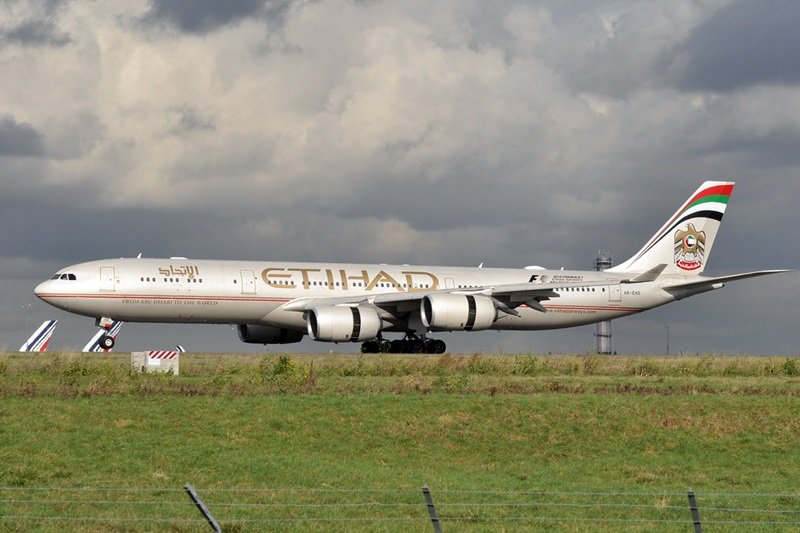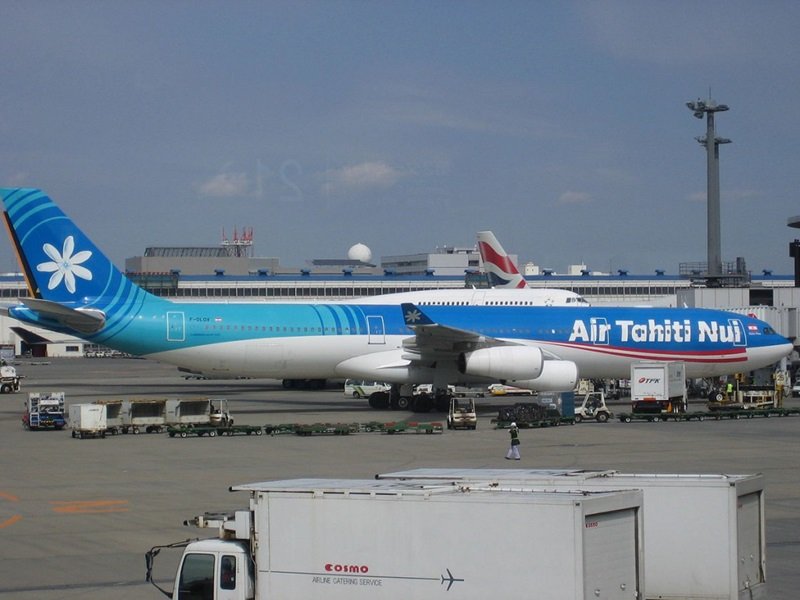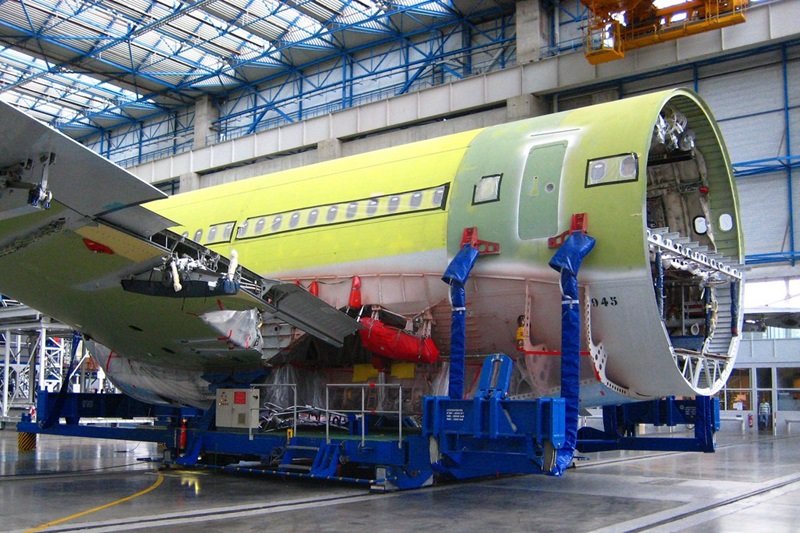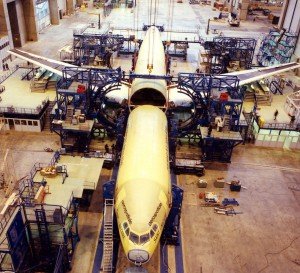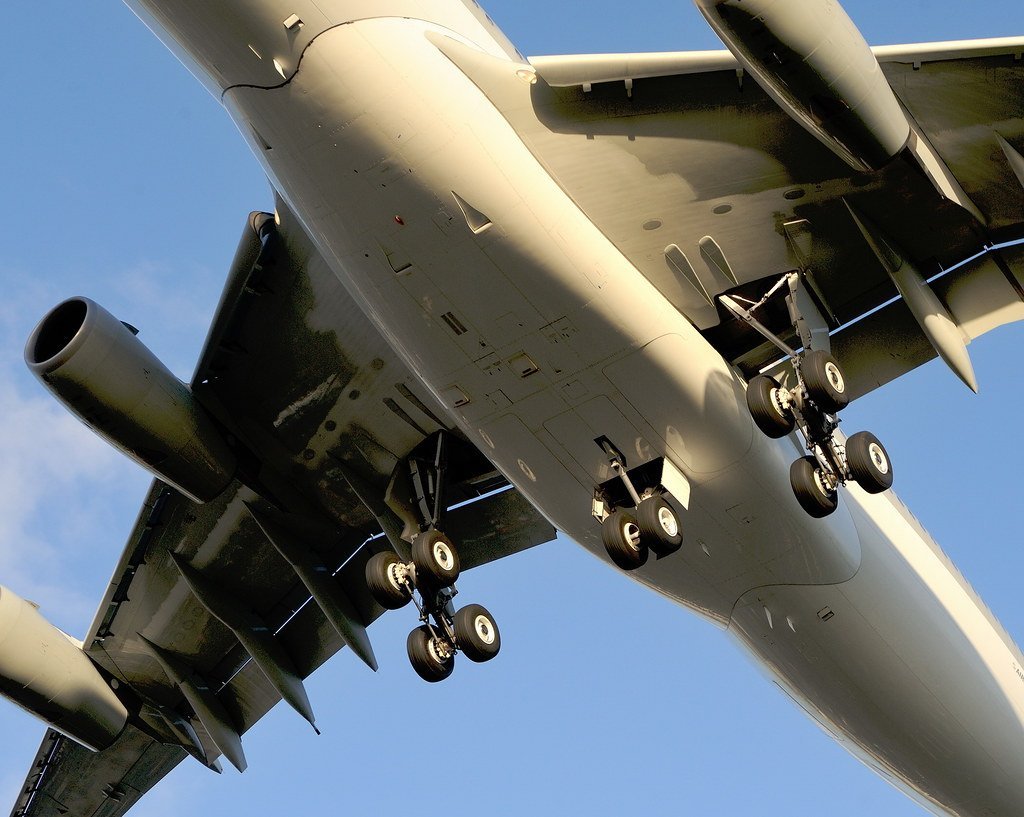
Airbus A340
HISTORY
ORDERS
SPECS
ASSEMBLY
Airbus A340-311, Lufthansa D-AIGK
The Airbus A340 aircraft is a wide-body four-engined jet airliner that was manufactured by Airbus Industrie. The first A340 flew in 1991 and 20 years later Airbus having filled all orders announced it would no longer be producing the type.
The A340 is a low-wing monoplane design and was slightly reminiscent of the Boeing 707 and Douglas DC8 with two engines on each wing and without the bubble on top like the Boeing 747. There are four variants of the A340; the A340 200 and A340 300 which were shorter and then the A340 500 and A340 600 which are longer. In fact, the A340 600 was the world's longest airliner until the introduction of the Boeing 777 300LR. Airbus showing pride in this aircraft painted on the fuselage of each one:
LONGER – FARTHER – LARGER – FASTER – HIGHER – QUIETER – SMOOTHER
The A340 was Airbus' first real long-range aircraft. It was put up as a contender for those airlines who were looking to replace their aging Boeing 747 100 and 747 200 fleets.
Airbus A340-541 Etihad Airways landing at Paris Charles de Gaul.
The A340 was Airbus' first real long-range aircraft. It was put up as a contender for those airlines who were looking to replace their aging Boeing 747 100 and 747 200 fleets.
The A340 was developed alongside the Airbus A330 which is a twin-engined jet airliner. The same wing, fuselage sections, and systems were employed for both aircraft and Airbus estimated it saved around US$500 million in development costs. As with all Airbus aircraft, the cockpit designs are the same across all their aircraft which is cost-saving for Airbus customers as they can move flight crew between types with only a week’s training.
So why did Airbus make two very similar aircraft?
In the late 80s when the program was announced, the ability or should I say the dependability of jet engines to not break down was reaching higher standards. As yet, however, many twin-engined airliners were still going through stringent ETOPS (Extended-range Twin-engine Operational Performance Standards) approval processes, so there was a reluctance by carriers with long over-water routes to commit to large twin-engined airliners for these routes.
The Airbus A340, was of course, immune to these limitations as was the Boeing 747, McDonnell Douglas DC-10, and the Lockheed L1011 Tristar. There was also a division of preference in the marketplace, with Asian carriers preferring 4 engines, US carriers preferring 2 engines and European carriers split between the two.
Air Tahiti Nui A340-313X (A343). Engines 4 x CFMI CFM56-5C4. First flight May 2005.
Some of the longest scheduled non-stop sectors were operated by the A340. Singapore Airlines in February of 2004 operated an A340 500 from Singapore to Los Angeles. In 2007 they went a step further and operated an A340 500 from Singapore to Newark (New Jersey) as SQ21, a distance of 15,344 km (8,285 NMI). This was the longest scheduled flight in the world.
In 2008, the doubling of oil prices forced airlines to reconsider some of these extra-long routes. The long flight sectors required heavy fuel loads which of course were made even worse by the amount of fuel required to lift and maintain flight with the extra fuel loads. Airlines started to reduce the sector lengths to try and economize on fuel spending. Some even started to sell off their A340s.
The time of the large twin jets was now at hand. Given, a large engine on something like a Boeing 777 is less economical than one of the A340 engines but as there are only two it makes the twin more viable. Fewer engines to maintain as well as carrying fewer engine spares was also a factor. So with all 375 orders filled the A340 was discontinued on 11 November 2011.
The Airbus A340 is succeeded by the Airbus A350 XWB family of aircraft.
The initiation of the Airbus A340/A330 project was a huge undertaking. Both in France and in the U.K., Airbus partners invested huge amounts in a new plant to make ready for the new airliners.
British Aerospace (BAe) extended its facilities in two locations. In Filton, Gloucestershire, near Bristol, they extended their 3-story technical facility by an additional 15,000 square metres (160,000 square feet) at a cost of UK£7 million. In Chester, Cheshire, a new wing production line was required and the plant had to be extended by 14,000 square metres (150,000 sq ft) at a further cost of UK£5 million.
As mentioned the wings and many other parts were manufactured in the U.K. by BAe. Contracts were also made with companies in many other countries, such as; Austria, Australia, Canada, China, Greece, Italy, India, Japan, South Korea, Portugal, U. S. A., and former Yugoslavia. for the manufacture of all the various components required to make a state-of-the-art airliner. The transport of the larger components to the final assembly line, such as wings, was done by a purpose-built Super Guppy, a very pregnant-looking version of the 1940s Boeing Stratocruiser. Boeing made some mileage out of the fact that every Airbus was delivered by a Boeing aircraft. These aircraft soon proved too costly to run and Airbus worked on a conversion of the A300 to come up with the A300-600ST (Super Transporter) "Beluga" which started service in September 1995 and still ferries Airbus' latest aircraft today.
ASSEMBLY
Airbus Toulouse Assembly Plant.
Naturally, the largest investment was going to be the actual final assembly plant. Aérospatiale for their part constructed a US$411 million assembly plant next to the Toulouse-Blagnac airfield in southern France. In late 1988 the great assembly hall started to take shape and was named the Clément Ader assembly hall, after the inventor, engineer, and aviation pioneer who lived his life in the area from 2 April 1841 until 3 May 1925.
Assembly stations at Toulouse.
Position 18/SC - Cabin sealing and gauge testing.
Position 19/20 - Mounting Engines and customer requirements.
Position 30 - Equipment installation and fuel tank seal testing.
Position 35 - Joining fuselage parts and installing electrical equipment.
Position 40 - Joining the wings to the center fuselage section.
Position 42/43 - Installation of avionics equipment.
A basic representation of the Toulouse Airbus assembly plant.
Airbus opted for automation for many of the assembly processes. This was reported to produce a 20 percent cost saving and a 5 percent improvement in time for the wing-to-fuselage joining process alone which employed 8 robots to drill the holes.
Another automation process was called S.O.J.A. ((Système Orbital de Jonction Automatisée(Semi-automated Orbital Fuselage Join up Robot)). This was used to join two sections of the fuselage together and consisted of two tower arrangements standing as tall as the fuselage itself. The towers enveloped the join area and two remote devices travelled the seam of the join and drilled, reamed, and countersunk a hole. It then inserted a small about of sealant which was followed by the fastener. On the inside, an operator would secure the fastener and inspect the work before S.O.J.A. would be allowed to move on to the next fastener.
A340 wing and centre fuselage section.
Due to the doubling of fuel prices in 2008, the A340 sales started to plummet as airlines opted for shorter routes to save on fuel. The day of the four-engined long-haul airliner seemed doomed. On 11 November 2011, Airbus announced the cessation of production of the A340 after 20 years of production.
The final two A340s were sold to AJW Capital Partners, an aviation services group based in the UK. They were A340 500s.
Airbus A340 getting ready for fuselage joining.
AIRBUS A340 SPECIFICATIONS
The Airbus A340 aircraft is a low-wing four-engined jet airliner developed and assembled by Airbus Industrie. The A340 was developed alongside the twin-engined A330, as discussed in our A340 history section below. Both the A330, A340 200 and A340 300 share the same wide body fuselage and wing design. The A340 500 and A340 600 which were developed later had a larger wing as they were designed for long non-stop flight routes.
Coming in four models of varying fuselage length, the A340 was developed for long distance flight at a time when the long distance twin jets of today were yet to make their mark. The variants numbered as; A340 200, A340 300, A340 500 and the A340 600 as shown in the table below all shared a common airframe with slight differences between them.
Air Canada. 340-313X Reg. C-GDVW was active from 02/06/1999 to 04/02/2009 and then sold to AirAsia X under Reg. 9M-XAB.
The A340 200 was the only model to have a wingspan greater than its' fuselage length.
The wings of the A340, like the A330, look long and narrow. Almost flimsy looking it gives both aircraft a look of grace. Aside from the aesthetics, which no doubt have little to do with the final design, the long narrow wings have a high aspect ratio making them very efficient in giving lift and allowing a high maximum speed of Mach 0.86.
The high thickness-to-cord ratio of 12.8 percent means that the thickness of the wing at its thickest point at any place along its length is 12.8 percent of the distance from the front of the wing to the rear of the wing at any given point. Compared to other aircraft this is quite high and allows for more strength to be built into the wing as well as more space for fuel.
Philippine Airlines Airbus A340 Wing.
The A340 500 and A340 600 were developed to be long-range high capacity airliners. Particularly the A340 500IGW (Increased Gross Weight) and the A340 600HGW(High Gross Weight) models.
Other than their longer fuselages, compared to the A340 200 and A340 300, they were also distinguishable by their four-wheeled under-fuselage centre wheel bogie. The A340 200 and A340 300 had a standard tricycle undercarriage with a 2 wheeled bogie under the nose, a 4 wheeled bogie under each wing, and an additional 2 wheeled bogie under the fuselage almost in line with the main under-wing bogies. The A340 500 and A340 600 sported the same centre under the fuselage bogie but with 4 wheels instead of 2. This was to support the significantly higher weights that these two aircraft were capable of lifting.
Virgin Atlantic Airbus A340-642 Reg G-VFIZ, London Heathrow, August 4th 2007. Here we can clearly see the centre bogie sporting four wheels.
Much of this weight, however, was, of course, fuel for some of the extremely long routes these aircraft flew.
At the time of the doubling of fuel prices in 2008, the Chief Executive of Air France - KLM was reported to have described the A340 500 as a flying tanker with a few people on board.
Qatar Airways A340-211. Here the undercarriage has the standard two wheel centre bogie.
A340 Specs Table
| Airbus A340 200 | Airbus A340 300 | Airbus A340 500 | Airbus A340 600 | |
|---|---|---|---|---|
| Range (fully laden) | 8,000nm (15,000Km) | 7,400nm (13,700Km) | 8,670nm (16,060Km) IGW: 9,000nm (17,000Km) |
7,750nm (14,350Km) HGW: 7,900nm (14,600Km) |
| Seating (Typical) | 240 (3 class) 300 (2 class) |
295 (3 class) 335 (2 class) |
313 (3 class) 359 (2 class) |
380 (3 class) 419 (2 class) |
| Competes against | Boeing 767-400ER | Boeing 777-200ER | Boeing 777-200LR | Boeing 777-300ER |
| Length | 59.39 m (194 ft 10 in) | 63.60 m (208 ft 8 in) | 67.90 m (222 ft 9 in) | 75.30 m (247 ft 1 in) |
| Wing span | 60.30 m (197 ft 10 in) | 63.45 m (208 ft 2 in) | ||
| Wing Area | 361.6 sq m (3,892 sq ft) | 439.4 sq m (4,730 sq ft) | ||
| Wing Sweep Back | 30 Degrees | 31.1 Degrees | ||
| Height (top of tail) | 16.70 m (54 ft 9 in) | 16.85 m (55 ft 3 in) | 17.10 m (56 ft 1 in) | 17.30 m (56 ft 9 in) |
| Fuselage Width (Exterior) | 5.64 m (18 ft 6 in) | |||
| Cabin width (Interior) | 5.28 m (17 ft 4 in) | |||
| Freight Volume | 162.8 cu m (5,750 cu ft) | 162.8 cu m (5,750 cu ft) | 153.9 cu m (5,430 cu ft) | 207.6 cu m (7,330 cu ft) |
| Undercarriage | 12 wheels. Nose Bogey - 2 wheels, Main Under Wing Bogey 4 wheels x 2, Centre Under Fuselage Bogey 2 wheels |
14 wheels. Nose Bogey - 2 wheels, Main Under Wing Bogey 4 wheels x 2, Centre Under Fuselage Bogey 4 wheels |
||
| Wheel Track | 10.69 m | 10.69 m | 10.69 m | 10.69 m |
| Wheel Base | 23.24 m | 25.6 m | 27.59 m | 32.89 m |
| Freight (underfloor) LD3 | 32 | 32 | 30 | 42 |
| Freight (underfloor) Pallets | 11 | 11 | 10 | 14 |
| Freight (underfloor) Bulk | 19.72 cu m | 19.7 cu m | 19.7 cu m | 19.7 cu m |
| Freight (underfloor) Total | 162.8 cu m | 162.8 cu m | 153.9 cu m | 207.6 cu m |
| Typical Operating Empty Weight | 129,000 kg (284,000 lb) | 130,200 kg (287,000 lb) | 170,900 kg (376,800 lb) IGW: 174,800 kg(385,400 lb) |
177,800 kg (392,000 lb) HGW: 181,900 kg(401,000 lb) |
| Cruising Speed | Mach 0.82 (871 kph / 470 kts at 11,000 m/36,000 ft) | Mach 0.83 (881 kph / 476 kts at 11,000 m/36,000 ft) | ||
| Maximum Operating Speed | Mach 0.86 (913 kph / 493 kts at 11,000 m/36,000 ft) | |||
| Maximum Ramp Weight | 275,000 kg | 275,900 kg | 373,200 kg | 369,200 kg |
| Maximum Take off Weight | 275,000 kg (606,000 lb) | 276,500 kg (609,600 lb) | 372,000 kg (820,000 lb) IGW: 380,000 kg (840,000 lb) |
368,000 kg (811,000 lb) HGW: 380,000 kg (840,000 lb) |
| Take off distance at Maximum Take off weight at sea-level ISA | 2,990 m (9,810 ft) | 3,100 m (10,200 ft) | 3,050 m (10,010 ft) | 3,100 m (10,200 ft) |
| Landing distance at at sea-level ISA | 1,890 m (6,200 ft) | 1,916 m (6,319 ft) | 2,094 m (6,870 ft) | 2,063 m (6,768 ft) |
| Service Ceiling | 12,500 m (41,000 ft) | |||
| Maximum Fuel Capacity | 155,040 litres (34,100 imp gal; 40,960 US gal) | 147,850 litres (32,520 imp gal; 39,060 US gal) | 214,810 litres (47,250 imp gal; 56,750 US gal) IGW: 222,000 litres (49,000 imp gal; 59,000 US gal) |
195,880 litres (43,090 imp gal; 51,750 US gal) HGW: 204,500 litres (45,000 imp gal; 54,000 US gal) |
| Engines | 4 x CFM56-5C | 4 x RR Trent 500 | ||
| Flight Crew | 2 | |||
| Price per aircraft at time of production. | US$187.5 Million | US$238.0 million | US$261.8 million | US$275.4 million |
| Airbus A340 200 | Airbus A340 300 | Airbus A340 500 | Airbus A340 600 | |
Designed in the 1970s, the Airbus A300 was Airbus' lead into the airliner manufacturing industry. This industry was at that time controlled mainly by American giants Boeing and Douglas. To break that stranglehold Airbus envisaged a family of airliners that would cover every sector of the industry, capacity-wise and also route lengthwise. To this end, they used the A300 and number-coded the various models as A300B1 through A300B9. Whilst they went ahead and produced the single-aisle A320 first, they then turned their attention back to a longer-haul twin-aisle version. The market was ready for a replacement for the aging Boeing 707 and Douglas DC8 aircraft.
The A300B9 was developed slowly and was to be a replacement for the Douglas DC10 and Lockheed L1011 tri-jets. It was to be a stretch of the A300 and would be more economical than the older jets. An A300B11 was then added to the plan to go up against the Douglas DC8 and Boeing 707. Both the A300B9 and A300B11 were to be twin-aisle aircraft and the designators were changed to TA(twin-aisle)9 and TA11. The initial specifications for these two types were released by Airbus in 1982.
History.
History Time Line for the Airbus A340 |
|
| Date | Milestone |
|---|---|
| 1982 | TA9 and TA11 (Twin Aisle) specifications were released for the first time. |
| June 1985 | Airbus had modified the design to incorporate the fly-by-wire concept of the A320 to the A340 design. A side-stick control instead of a central control column would be used. |
| 27 January 1986 | In Munich, Airbus announced the re-designation of the TA11 to become the A340 and asked for interest from airlines in becoming a launch customer. |
| 12 May 1986 | Airbus sent out sales proposals to Lufthansa, Swissair, and 3 other airlines. |
| 05 June 1987 | The A340 and A330 program is officially launched by Airbus. |
| 02 August 1991 | Singapore Airlines cancels a 20 aircraft MD-11 order due to disappointing performance and orders 20 A340 300s. |
| 21 October 1991 | The maiden flight of the A340 300. |
| 22 December 1992 | J.A.A. (Joint Aviation Authority - Europe) certification received. |
| 27 May 1993 | F.A.A. (Federal Aviation Authority - U.S.A.) certification received. |
| 02 February 1993 | Lufthansa receives their first A340 200, named Nürnberg she had 228 seats. |
| 26 February 1993 | Air France take delivery of their first of 9 A340 300s. This aircraft was Airbus' 1000th aircraft delivered. |
| 15 March 1993 | Lufthansa's A340 Nürnberg commenced service on the Frankfurt to New York route. |
| 16 June 1993 | A340 200 World Ranger makes her showcase flight from the Paris Airshow to Auckland, New Zealand and returns in 48 hours and 22 minutes, breaking 6 world records including the longest non-stop flight by an airliner which stood for 12 years. |
| August 1997 | Virgin Atlantic announces they will be the launch customer for the A340 600 |
| 23 April 2001 | The maiden flight of the A340 600 |
| 11 February 2002 | The maiden flight of the A340 500 |
| July 2002 | Virgin Atlantic take delivery of their first A340 600 named "Claudia Nine" by Claudia Shiffer at the Farnborough Airshow. |
| 3 December 2002 | The A340 500 receives European certification. |
| November 2003 | The A340 500 enters service with Emirates who were the default launch customer after Air Canada the original launch customer filed for bankruptcy. |
| February 2004 | Singapore commences the longest non-stop commercial flight route with an A340 500. Singapore to Los Angeles. |
| 28 June 2004 | Singapore Airlines extends flight SQ21 as a non-stop flight from Singapore to Newark NJ with the A340 500, a distance of 15,343 km (9,534 nm ). |
| 01 July 2008 | Thai International Airlines discontinued their 17-hour non-stop services from Bangkok to Los Angeles and sold their 4 A340 500s. The doubling of jet fuel prices was the reason given. |
| August 2008 | Cathay Pacific terminated their non-stop trans-Pacific routes and redeploy their A340 500s to shorter routes. |
| 10 November 2011 | Airbus announced that the A340 program had ended. All orders had been filled and 377 aircraft had been delivered. The acceptance of large twin-engined aircraft on long over-water routes had spelled the end of this once popular 4-engined airliner. |
BWIA Airbus A340-300
At one point Airbus and McDonnell Douglas held discussions investigating a joint venture aircraft dubbed the AM300. This fell apart as McDonnell Douglas insisted on a tri-jet configuration, something that Airbus could not agree to.
The TA9 and TA11 designators were originally reversed but it made sense that the four-engined version should carry the designator with a 4 in it, so the A340 four-engined airliner came into being. The TA9 and TA11 become the A330 and A340 program which was officially announced by Airbus in Munich on 27 January 1986, when they called for interest for a launch customer. In May of that year, they sent sales proposals to 5 major airlines for both types.
Whilst general specifications had been decided upon, specific design fine-tuning was still ongoing, some of those ideas were feasible while others were not. For example; Airbus looked into a variable-shaped wing that would change to an optimum camber shape dependent on the phase of flight the aircraft was in. This would have produced a 2% improvement in fuel economy but was dropped as it was too hard to develop.
Singapore Airlines Airbus A340-500 Reg. 9V-SGA at LAX. The Singapore Airlines Airbus A340-300s were named 'Celestar', with the title used heavily in the aircraft's branding when they joined the fleet in 1996.
The A330 / A340 program was officially launched just prior to the 1987 Paris Airshow by the end of which they received 89 orders for the type.
The first flight of the A340 was on 21 October 1991 and was done by the initial variant the A340 300. Six aircraft then began a 2,000-hour rigorous test program which culminated in certification for the type given by the J.A.A. (Joint Aviation Authority - Europe) on 22 December 1992 and the F.A.A. (Federal Aviation Authority - U.S.A.) on 27 May 1993.
At the Paris airshow of 1993, Airbus pulled off a showcase stunt using an A340 200 called World Ranger. With extra fuel tanks and 22 people on board, the aircraft lifted off just before lunch at 11:58 on 16 June 1993 and flew non-stop to Auckland, New Zealand, where it refueled and flew straight back to Paris where it arrived in time for lunch two days later with a flying time of 48 hours and 22 minutes. The flight broke 6 world records, including the longest non-stop flight by an airliner at 19,277 km (10,409 nm). This record stood for 12 years until broken by a Boeing 777 200LR in November 2005 for a Hong Kong to London flight of 21,602 km (11,664 nm).
The first Airbus A340 four-engined, long-range, wide-bodied passenger transports were placed into service by Lufthansa and Air France in March of 1993. The Airbus A340 Orders and Deliveries show how this airliner bridged the gap between the older jets and the giant twins.
A340 aircraft was seen as the answer to long-range flights in the future as the older DC8 and Boeing 707 had all but disappeared from the skies. A sleek-looking airliner, it set some records which stood for many years as discussed in our History section.
Orders and Deliveries.
Cathay Pacific Airbus A340-600. Reg. B-HQB
The Airbus adage 4 Engines 4 Long Haul was aimed at the upcoming twin jets like the Boeing 777 which were still seeking ETOPS certification to be able to fly their twin jets on long over-water routes. There were 4 variants of the A340 with the main difference being fuselage length but there were also extended range specs added to the later A340 500 and A340 600.
The A340 300 was the most popular version sold making up 58 percent of all A340s sold. The advent of the fuel price hikes in 2008 ensured that the A340 was doomed to fail. Fortunately for Airbus, the A340 and the A330 shared many common designs such as fuselage and wings. So where the A340 was deemed a failure for Airbus the A330 has been a huge success and continues to make good money for Airbus.
Air Jamaica Airbus A340-300 Reg. 6Y-JMP
Below are the launch customers for each of the A340 variants.
On 02 February 1993, Lufthansa became the launch customer for the Airbus A340 200. The aircraft entered service on 15 March 1993.
On 26 February 1993, Air France as the launch customer for the Airbus A340 300 took delivery of their first aircraft. The aircraft entered service in March of that year.
In November 2003 the Airbus A340 500 entered service with Emirates and became the default launch customer after Air Canada filed for bankruptcy.
On 22 July 2002 Virgin Atlantic as the launch customer took delivery of their first A340 600. At a ceremony at Heathrow, it was named (Cloud) Claudia Nine after Claudia Shiffer.
Order Summary.
| Airbus A340 | |
|---|---|
| Total Orders | 377 |
| Total Deliveries | 377 |
| Aircraft in Operation | 203 |
| Number of Operators | 47 |
| Number of Customers | 48 |
Correct as at end of November 2022.
Order Summary by Variant.
| Breakdown by aircraft | Airbus A340 200/300 | Airbus A340 500/600 |
|---|---|---|
| Orders | 246 | 131 |
| Deliveries | 246 | 131 |
| In Operation | 110 | 93 |
Correct as at end of November 2022.
Airline Customers of the A340.
Correct as at end of November 2022.
| Customer | Nationality | A340 200 / A340 300 | A340 500 / A340 600 | ||||
|---|---|---|---|---|---|---|---|
| Ord | Del | Opr | Ord | Del | Opr | ||
| Gov. Exec. and Private Jets | Various | 7 | 7 | 12 | 7 | 7 | 11 |
| Aerolineas Argentinas | Argentina | 2 | |||||
| Air Atlanta Icelandic | Iceland | 1 | |||||
| Air Belgium | Belgium | 3 | |||||
| Air Canada | Canada | 8 | 8 | 2 | 2 | ||
| Air China | China | 3 | 3 | ||||
| Air China Southwest Company | China | 3 | 3 | ||||
| Air France | France | 14 | 14 | ||||
| Airhub Airlines | Malta | 2 | |||||
| Air Madagascar | Madagascar | 1 | |||||
| Air Mauritius | Mauritius | 5 | 5 | ||||
| Air Tahiti Nui | French Polynesia | 4 | 4 | ||||
| Air X Charter | Malta | 2 | |||||
| AJW Capital Partners LTD | United Kingdom | 2 | 2 | ||||
| Arik Air | Nigeria | 2 | 2 | 1 | |||
| Austrian Airlines | Austria | 4 | 4 | ||||
| Avior Airlines | Venezuela | 1 | |||||
| Azerbaijan Airlines | Azerbaijan | 2 | |||||
| Azman Air | Azerbaijan | 1 | |||||
| Cathay Pacific | Hong Kong | 11 | 11 | ||||
| China Airlines | Taiwan, Rep. of China | 6 | 6 | ||||
| China Eastern Airlines | China | 5 | 5 | 5 | 5 | ||
| Conviasa | Venezuela | 1 | 1 | ||||
| Edelweiss Air | Switzerland | 4 | |||||
| EgyptAir | Egypt | 3 | 3 | ||||
| Emirates | United Arab Emirates | 10 | 10 | ||||
| Etihad Airways | United Arab Emirates | 11 | 11 | ||||
| European Cargo | United Kingdom | 2 | |||||
| European Skybus | United Kingdom | 10 | |||||
| Finnair | Finland | 4 | 4 | ||||
| Flight Lease | Switzerland | 2 | 2 | ||||
| Global Airways | South Africa | 4 | |||||
| Gulf Air | Bahrain | 6 | 6 | ||||
| Hi Fly Malta | Malta | 6 | |||||
| Iberia | Spain | 18 | 18 | 16 | 16 | 4 | |
| ILFC | United States | 16 | 16 | 13 | 13 | ||
| Iran Aseman Airline | Islamic Republic of Iran | 1 | |||||
| Kam Air | Afghanistan, Islamic Republic of | 3 | |||||
| Kuwait Airways | Kuwait | 4 | 4 | ||||
| LATAM Airlines Group S.A | Chile | 4 | 4 | ||||
| Legend Airlines | Romania | 5 | |||||
| Lufthansa | Germany | 35 | 35 | 17 | 24 | 24 | 17 |
| Mahan Air | Iran, Islamic Rep. of | 5 | 7 | ||||
| Maleth Aero | Malta | 4 | |||||
| Meraj Airlines | Iran | 1 | |||||
| Olympic Airlines | Greece | 4 | 4 | ||||
| Philippine Airlines | Philippines | 8 | 8 | ||||
| Plus Ultra Lineas Aereas | Spain | 2 | 1 | ||||
| Qatar Airways | Qatar | 4 | 4 | ||||
| Sabena | Belgium | 5 | 5 | ||||
| Sands Aviation, LLC | United States | 1 | |||||
| Scandinavian Airlines | Sweden | 7 | 7 | 5 | |||
| Singapore Airlines | Singapore | 17 | 17 | 5 | 5 | ||
| South African Airways | South Africa | 6 | 6 | 3 | 6 | 6 | 4 |
| Sri Lankan Airlines | Sri Lanka | 3 | 3 | ||||
| Swiss International Air Lines | Switzerland | 9 | 9 | 5 | |||
| Syrian Air | Syrian Arab Republic | 2 | |||||
| TAP Portugal | Portugal | 4 | 4 | ||||
| Thai | Thailand | 10 | 10 | ||||
| Turkish Airlines | Turkey | 7 | 7 | ||||
| USC | Germany | 1 | |||||
| Ukrainian Wings | Ukraine | 1 | |||||
| U.T.A. | France | 7 | 7 | ||||
| Virgin Atlantic | United Kingdom | 7 | 7 | 14 | 14 | ||
| Undisclosed | 31 | 23 | |||||
| TOTALS | 246 | 246 | 110 | 131 | 131 | 93 | |
On 10 November 2011, Airbus having fulfilled all Airbus A340 orders announced that was ceasing production of this aircraft. Almost 19 years of production were at an end. The age of the super-sized twin jets has superseded the 4 engined jets other than the A380 Super Jumbo and the Boeing 747 8 Intercontinental. The A340 is succeeded in the Airbus fleet by the A330 and the A350 which look to take Airbus well into the future. It is interesting to note in the table below how second-hand A340s are still being picked up by smaller airlines, so as they disappear from mainstream airline stables they start turning up somewhere else.






